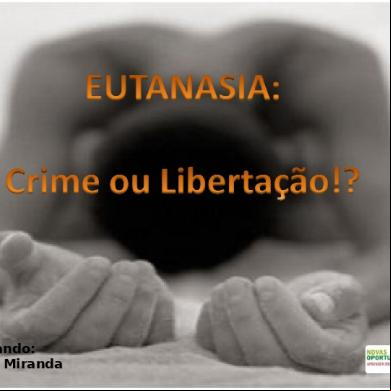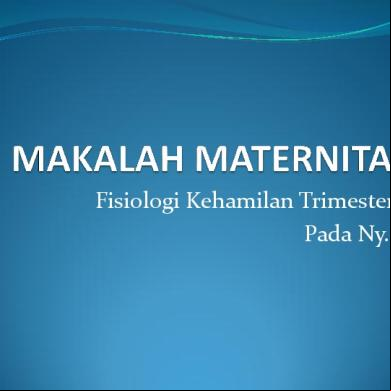Powerpoint 4zy6k
This document was ed by and they confirmed that they have the permission to share it. If you are author or own the copyright of this book, please report to us by using this report form. Report 3b7i
Overview 3e4r5l
& View Powerpoint as PDF for free.
More details w3441
- Words: 755
- Pages: 10
MARIA MONTESSORI
August 31, 1870 – May 6, 1952
CHILDHOOD EXPERIENCES Maria Montessori was born into an upper middle class family in Chiaravalle, Italy on August 31,1870. In Italy, at that time, girls basically had two career options, a teacher or a nun. Her father, Alessandro, worked as a financial manager for a state-owned industry. Her mother, Renilde Stoppani was very well educated and an avid reader, which was unusual for women in this time. Maria must of taken her love for learning after her mother because at the age of 13, without the consent of her father but with the of her mother, she enrolled in an all-boy technical school to prepare her for a career in engineering.
FAMILY LIFE At the turn of the century Maria Montessori, a thirty-year-old medical doctor, mothered her only child Mario Montessori outside of marriage to Giuseppe Montesano .
EDUCATION “The Montessori family moved to Rome in 1875, and the following year the young Maria enrolled in the local state school on the Via di San Nicolo da Tolentino. As her education progressed, she began to break through the barriers which constrained women’s careers. From 1886 to 1890 she continued her studies at the Regio Instituto Tecnico Leonardo da Vinci, which she entered with the intention of becoming an engineer. This was unusual at the time as most girls who pursued secondary education studied the classics rather than going to technical school. Upon her graduation, Montessori’s parents encouraged her to take up a career in teaching, one of the few occupations open to women at the time, but she was determined to enter medical school and become a doctor. Her father opposed this course—medical school was then an all-male preserve—and initially Maria was refused entry by the head of school. She was undeterred, apparently ending the unsuccessful interview with the professor by saying, “I know I shall become a doctor”
WHO INFLUENCED HER Maria Montessori was profoundly influenced by Fredrich Froebel, the inventor of kindergarten, and by Johann Heinrich Pestalozzi, who believed that children learned through activity. She also drew inspiration from Itard, Seguin and Rousseau. She enhanced their approaches by adding her own deeply felt belief that we must follow the child. One does not teach children, but rather creates a nurturing climate in which children can teach themselves through creative activity and exploration. Montessori was so convinced that these mentally deficient children could be helped that she travelled to London and Paris to study the work of two pioneers in this area, Jean Itard and Eduoard Seguin. She was subsequently greatly influenced by their ideas and methods. Edouard Seguin (Montessori: The Discovery of the Child), was a student under Itard and he later founded his own school for deficients in Paris.Seguin describes his method as physiological as he began by educating the muscular system and the senses. Starting by teaching children with learning difficulties how to walk, he guided their learning through a series of increasingly complex activities.
THE MONTESSORI METHOD Maria believed that children went through a series of “sensitive periods” with “creative moments” when they all of a sudden get the urge to learn. This time should be used well because this is when they have the greatest ability to learn. They should not be held back by forced curriculum (plans of study) or classes. Work, she believed, is its own reward to the child, and there is no necessity for other rewards. “Self-discipline (controlling oneself) emerges out of the freedom of the learning environment.” The Montessori method of teaching is the biggest thing that Maria Montessori has contributed to early childhood. Maria Montessori was more than just a woman seeking how to better educate young children. She was someone who had a real mission in life, someone who dedicated herself to understanding how and why children learn.
METHOD CONT. Her method represents a scientific approach to education. The secret of childhood resides in the fact that through their spontaneous activity, children labor to "make themselves into men" [Montessori, 1964]. Mental development, similar to physical growth, is the result of a natural, internally regulated force. Liberty is the imperative ingredient that enables education to assist the "unfolding of a child's life" [Montessori, 1964].Order, most especially within the child, but also in the child's environment, is prerequisite to the child becoming an independent, autonomous, and rational individual. (Goffin, 1994, p. 49)
RESOURCES • http:// novaonline.nvcc.edu/eli/evans/his135/events/montessor i52/montessori52.html • http:// amshq.org/Montessori-Education/History-of-Montessori-E ducation/Biography-of-Maria-Montessori • https://montessori.org.au/montessori/biography.htm • http://privateschool.about.com/od/primarygrades/a/What -Is-A-Montessori-School.htm • http://www.montessori.org.uk/magazine-and-jobs/library _and_study_resources/teacher-training-study-resources/ maria_montessori_1870_-_1952 • http://www.education.com/reference/article/maria-montes sori/
THE END
August 31, 1870 – May 6, 1952
CHILDHOOD EXPERIENCES Maria Montessori was born into an upper middle class family in Chiaravalle, Italy on August 31,1870. In Italy, at that time, girls basically had two career options, a teacher or a nun. Her father, Alessandro, worked as a financial manager for a state-owned industry. Her mother, Renilde Stoppani was very well educated and an avid reader, which was unusual for women in this time. Maria must of taken her love for learning after her mother because at the age of 13, without the consent of her father but with the of her mother, she enrolled in an all-boy technical school to prepare her for a career in engineering.
FAMILY LIFE At the turn of the century Maria Montessori, a thirty-year-old medical doctor, mothered her only child Mario Montessori outside of marriage to Giuseppe Montesano .
EDUCATION “The Montessori family moved to Rome in 1875, and the following year the young Maria enrolled in the local state school on the Via di San Nicolo da Tolentino. As her education progressed, she began to break through the barriers which constrained women’s careers. From 1886 to 1890 she continued her studies at the Regio Instituto Tecnico Leonardo da Vinci, which she entered with the intention of becoming an engineer. This was unusual at the time as most girls who pursued secondary education studied the classics rather than going to technical school. Upon her graduation, Montessori’s parents encouraged her to take up a career in teaching, one of the few occupations open to women at the time, but she was determined to enter medical school and become a doctor. Her father opposed this course—medical school was then an all-male preserve—and initially Maria was refused entry by the head of school. She was undeterred, apparently ending the unsuccessful interview with the professor by saying, “I know I shall become a doctor”
WHO INFLUENCED HER Maria Montessori was profoundly influenced by Fredrich Froebel, the inventor of kindergarten, and by Johann Heinrich Pestalozzi, who believed that children learned through activity. She also drew inspiration from Itard, Seguin and Rousseau. She enhanced their approaches by adding her own deeply felt belief that we must follow the child. One does not teach children, but rather creates a nurturing climate in which children can teach themselves through creative activity and exploration. Montessori was so convinced that these mentally deficient children could be helped that she travelled to London and Paris to study the work of two pioneers in this area, Jean Itard and Eduoard Seguin. She was subsequently greatly influenced by their ideas and methods. Edouard Seguin (Montessori: The Discovery of the Child), was a student under Itard and he later founded his own school for deficients in Paris.Seguin describes his method as physiological as he began by educating the muscular system and the senses. Starting by teaching children with learning difficulties how to walk, he guided their learning through a series of increasingly complex activities.
THE MONTESSORI METHOD Maria believed that children went through a series of “sensitive periods” with “creative moments” when they all of a sudden get the urge to learn. This time should be used well because this is when they have the greatest ability to learn. They should not be held back by forced curriculum (plans of study) or classes. Work, she believed, is its own reward to the child, and there is no necessity for other rewards. “Self-discipline (controlling oneself) emerges out of the freedom of the learning environment.” The Montessori method of teaching is the biggest thing that Maria Montessori has contributed to early childhood. Maria Montessori was more than just a woman seeking how to better educate young children. She was someone who had a real mission in life, someone who dedicated herself to understanding how and why children learn.
METHOD CONT. Her method represents a scientific approach to education. The secret of childhood resides in the fact that through their spontaneous activity, children labor to "make themselves into men" [Montessori, 1964]. Mental development, similar to physical growth, is the result of a natural, internally regulated force. Liberty is the imperative ingredient that enables education to assist the "unfolding of a child's life" [Montessori, 1964].Order, most especially within the child, but also in the child's environment, is prerequisite to the child becoming an independent, autonomous, and rational individual. (Goffin, 1994, p. 49)
RESOURCES • http:// novaonline.nvcc.edu/eli/evans/his135/events/montessor i52/montessori52.html • http:// amshq.org/Montessori-Education/History-of-Montessori-E ducation/Biography-of-Maria-Montessori • https://montessori.org.au/montessori/biography.htm • http://privateschool.about.com/od/primarygrades/a/What -Is-A-Montessori-School.htm • http://www.montessori.org.uk/magazine-and-jobs/library _and_study_resources/teacher-training-study-resources/ maria_montessori_1870_-_1952 • http://www.education.com/reference/article/maria-montes sori/
THE END










